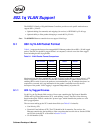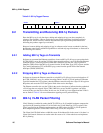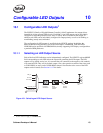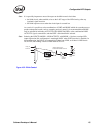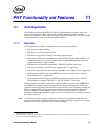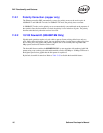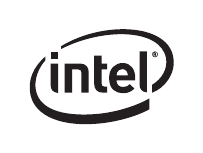
184 Software Developer’s Manual
Configurable LED Outputs
LED outputs can be based on the following expressions:
• LINK_UP is asserted while link of any speed is maintained
• LINK_10 indicates link at 10 Mbps
• LINK_100 indicates link at 100 Mbps
• LINK_1000 indicates link at 1000 Mbps
• LINK_100/1000 indicates link at either 100 or 1000 Mbps
• LINK_10/1000 indicates link at either 10 or 1000 Mbps
• ACTIVITY is asserted when link is established and packets are being transmitted or received
• LINK/ACTIVITY is asserted when link is established but there is NO transmit or receive
activity
• COLLISION is asserted each time a collision is observed
• PAUSED is asserted while the Ethernet controller’s transmitter is paused due to flow control
• PCIX_MODE is asserted when the Ethernet controller is in PCI-X mode (versus PCI mode)
• FULL_DUPLEX is asserted when the link is configured for full duplex operation
• BUS_SPEED is asserted in PCI 66 MHz or PCI-X 133 MHz configurations (high-speed
operation)
• BUS_SIZE is asserted in 64-bit PCI or PCI-X configurations
• LED_ON is always asserted (low); LED_OFF is always deasserted (high)
10.1.2 Polarity Inversion
The LEDCTL.IVRT field enables the selected LED source to be optionally inverted. This can be
used to drive external circuitry where an active high indication of one of the selectable states/
events is required (such as multi-color LED circuits).
Note: Polarity inversion (LEDCTL.IVRT = 1b) and blinking (LEDCTL.BLINK = 1b) at the same time
for a given LED is not recommended. Introducing additional polarity inversion on a selected state/
event while blink-control is also enabled can produce nonsensical LED behavior (such as blinking
LED’s during periods of NO activity or when link is down).
10.1.3 Blink Control
Each LED’s output circuitry also includes a blink-control circuit that can additionally be enabled.
The blink control circuitry turns its output sequentially on (low) for 200 ms, then off for another
200 ms, each time its input is active/asserted. The LEDCTL.BLINK field controls whether a blink
circuit is enabled for an LED output.
The blink control is especially useful for ensuring that certain brief events, such as momentary
ACTIVITY or COLLISION events, cause LED transitions which are sufficiently visible to a
human eye. The circuit re-evaluates after each on/off blink cycle, ensuring a continuous blink
pattern throughout periods of continuous event/state assertion (such as heavy ACTIVITY periods
or long PAUSED times).






